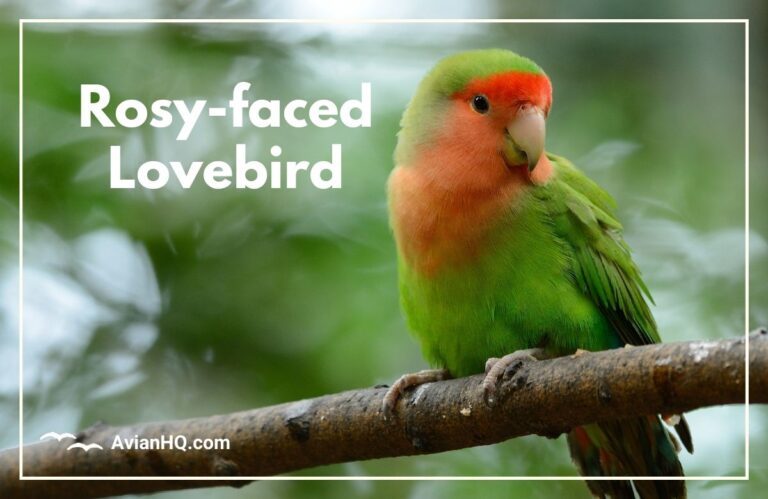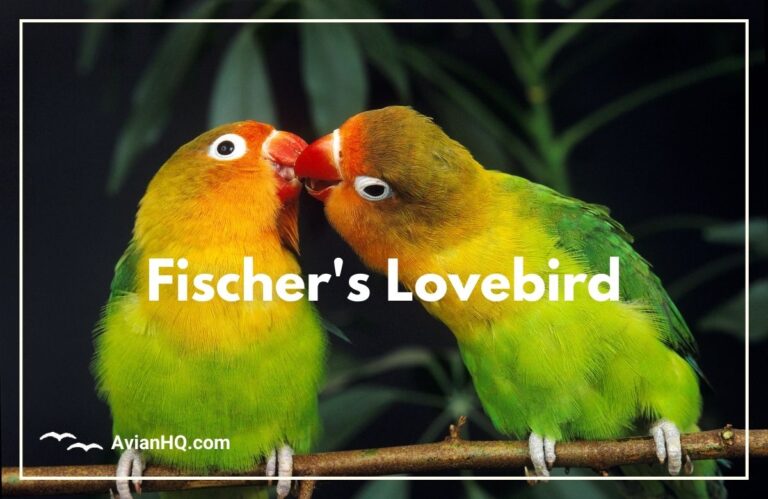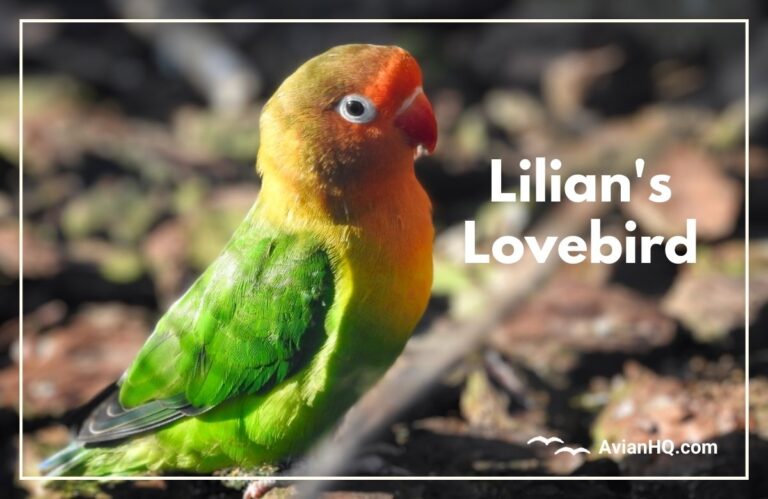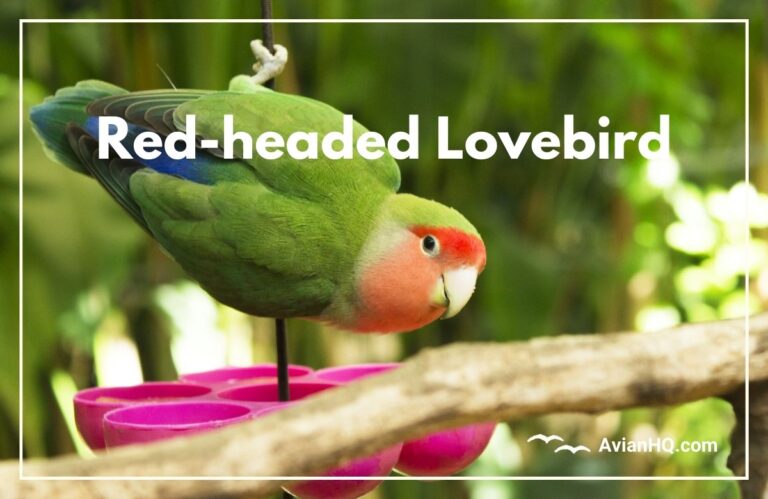Black-winged Lovebird (Agapornis taranta)
You glance up into the trees and catch a glimpse of bright red feathers. A small parrot with a colorful forehead peeks out from the branches. You’ve spotted the Black-winged Lovebird, one of Africa’s beautiful highland birds.
“The Black-winged Lovebird stands out with its red and green plumage.”
Known for its vibrant colors, the Black-winged Lovebird lives only in the mountains of Eritrea and Ethiopia. Growing up to 6.5 inches (16.5 centimeters) long, it’s one of the largest members of the lovebird family.
These parrots form close bonds with flockmates and may gather in groups of 4 to 20 birds. Flocks will chatter and call to each other as they flit through the forest canopy foraging for fruit and seeds. You can recognize the Black-winged Lovebird by its bright red forehead and green body. Only the male has this dazzling scarlet face that almost glows amidst the green foliage.
Despite its beauty, the Black-winged Lovebird remains uncommon in captivity. Challenges breeding this species have kept its numbers low outside of Africa. But in aviaries around the world, these lovebirds draw admiration for their vibrant feathers. Their quiet disposition also suits them well for pets.
As you read on, you’ll learn more about the life and ecology of the stunning Black-winged Lovebird. We’ll cover details on its appearance, diet, reproduction, behavior, habitat, and conservation status both in the wild and in captivity.
History and Taxonomy
The Black-winged Lovebird was first described scientifically in 1814 by the English explorer Henry Salt during his travels in Africa. He named the species Psittacus taranta in reference to the Taranta Pass in Eritrea where he observed these birds.
“The Black-winged Lovebird’s scientific name comes from the Taranta Pass in Eritrea.”
In the 1800s, many European explorers ventured across Africa, documenting the wildlife they encountered. Species were often named after the geographical locations where they were first spotted. The genus name Agapornis combines the Greek words for “love” (agape) and “bird” (ornis)—a fitting name for these affectionate parrots.
The common name “lovebird” refers to the strong bonds these small parrots form with their mates and flockmates. But only the Black-winged Lovebird species carries the taranta name to recognize where it was first discovered by Western science.
Today, the Black-winged Lovebird has the scientific name Agapornis taranta. No distinct subspecies are recognized across its limited range in the Ethiopian highlands.
Physical Appearance
The Black-winged Lovebird reaches 6 to 6.5 inches (15 to 16.5 centimeters) in length from beak to tail tip. Females tend to be very slightly larger than males. These lovebirds weigh approximately 1.5 to 1.9 ounces (44 to 53 grams).
This species shows vibrant color differences between the sexes. The male sports a bright red forehead and eye rings that stand out sharply against his green feathers. His primary wing and tail feathers are blackish, while the rest of his body plumage is a rich green accentuated by yellow and olive tones.
The female lacks the male’s red and black accents. Her green plumage extends over the head and wings without contrasting markings. However, females do share the male’s coral red beak, grey legs, and white eyerings.
“Only the vivid red forehead distinguishes the male Black-winged Lovebird.”
After their first molt at 6-9 months old, young Black-winged Lovebirds attain adult plumage. Before this molt, immature males already show some black on their wings. This helps distinguish their gender early on.
No distinct subspecies of the Black-winged Lovebird exist across its small native range. All populations share the same vibrant green, black, and scarlet coloration.
Habitat and Distribution
The Black-winged Lovebird resides only in the highland forests and mountains of Eritrea and Ethiopia in eastern Africa. This species is endemic to the Ethiopian Highlands, restricted to a small geographic range across just these two countries.
These parrots live at elevations between 5,900 and 10,500 feet (1,800 and 3,200 meters). Their native habitat consists of montane forests interspersed with grassland savannas. They also occupy wooded areas dotted with acacia, combretum, and other trees.
Flocks forage for fruit and seeds while navigating the high altitude terrain. They may also fly to lower valleys closer to human cultivation looking for food. But their numbers concentrate mainly in thickly forested mountain habitats.
While aviculture has introduced some small captive populations abroad, no viable exotic populations have established. The Black-winged Lovebird remains endemic to Eritrea and Ethiopia. Habitat loss does pose concerns for the future as forests get cleared for agriculture and development.
“This uniquely colorful lovebird lives only in the central Ethiopian highlands.”
Diet and Feeding
In the wild, the Black-winged Lovebird follows a mainly herbivorous diet consisting of seeds, fruits, vegetables, and sprouts. This offers a mix of proteins, carbohydrates, fats, and nutrients to sustain an active lifestyle at high altitudes.
Flocks forage amongst tree branches for favorite foods like figs, juniper berries, corn, and sunflower seeds. Their sturdy beaks and tongues help them access seeds and fruits. They use their feet to grasp and manipulate food items as well.
Lovebirds meet their hydration needs from the moisture content in the foods they eat. But wild flocks may also drink rainwater collected in arboreal reservoirs or dew gathered on leaves. Captive lovebirds should always have clean drinking water available in their enclosures.
In aviaries, these lovebirds thrive on a quality seed mix containing millets, oats, wheat, and canary seeds. Supplements can include vegetables like carrots and broccoli, plus fruits like apples and oranges. Complete pellets also supply balanced nutrition for pets and aviary birds.
“A diverse diet of seeds, sprouts, veggies and fruits sustains the active Black-winged Lovebird.”
Breeding and Reproduction
The breeding season for Black-winged Lovebirds extends from March through November. These months correspond with the rainy period in their Ethiopian habitat.
Lovebirds form monogamous pairs during each breeding season. They nest in tree cavities, choosing holes excavated by woodpeckers or natural recesses that accumulate nesting materials. The female prepares the nest and settles into her incubation duties while relying on her partner to bring food to her.
A complete clutch contains 3 to 4 white eggs measuring about 0.9 by 0.7 inches (24.5 by 19 millimeters). Only the female incubates the eggs, keeping them warm beneath her body for 23 to 24 days.
Both parents share feeding responsibilities once the chicks hatch. The young fledge at around 45 days old, but may continue begging parental care for another couple weeks as they perfect their flying and foraging abilities. Most pairs will mate for life and breed together each spring.
“Lovebird parents share a strong bond as they nurture their chicks together.”
The biggest challenge arises when attempting to breed Black-winged Lovebirds in captivity. Despite success with other lovebird species, this one remains tricky to reproduce consistently outside its native region.
Behavior and Ecology
Part of what makes lovebirds so endearing are their affectionate behaviors and social nature. Black-winged Lovebirds congregate in small flocks of 4 to 20 individuals outside the breeding season.
Their groups roost communally in tree cavities, lining the inside with leaves, twigs, and feathers to create a cozy shelter. Flocks break off into monogamous pairs during the spring breeding season, but reunite when winter comes again.
These lovebirds maintain constant vocal contact with soft chirrups and twitters. Their high-pitched calls can sound shrill when the flock takes flight all together. But Black-winged Lovebirds are generally quieter than their brightly colored relatives.
While feeding, the birds forage actively among high branches searching for ripening fruits and seeds. Their nibbling and climbing does not damage trees severely compared to larger parrots. But Lovebirds still get categorized as minor crop pests to local cultivation.
Peaceful by nature, Black-winged Lovebirds show aggression mainly when defending nest sites or competing for resources. Their beaks can deliver a notable bite, so even small birds don’t confront larger species unless their territory gets invaded.
“High-flying flocks stay connected through a chorus of chatter and tweeting calls.”
Conservation Status
The Black-winged Lovebird maintains a sufficiently large and widespread population across its native range. The species rates as Least Concern on the IUCN Red List of Threatened Species.
While detailed surveys are lacking, general observations suggest Black-winged Lovebird numbers remain decently high. Groups gathering at plentiful food sources can form large, noisy flocks temporarily.
However, the dependence on high altitude forests makes this lovebird vulnerable to habitat degradation from logging and land conversion. Ethiopia faces heavy pressures of deforestation and soil erosion across its highlands.
Both Ethiopia and Eritrea have established protected parks and reserves in areas of prime lovebird habitat. But stronger environmental policies and sustainable development plans will be needed to ensure the long term survival of all wildlife dependent on these mountain ecosystems.
In captivity, limited breeding success has prevented the Black-winged Lovebird population from growing more substantially abroad. Aviculture experts continue working to better understand the obstacles for successfully hatching and raising chicks of this species. Their vibrant beauty and quiet nature means demand remains strong for adding these lovebirds to private collections and zoos worldwide.
“Monitoring highland habitat loss helps guide conservation actions needed for this Ethiopian endemic.”
Conclusion
The vibrant green and red plumage of the Black-winged Lovebird makes this parrot stand out amongst its highland forest habitat. While many lovebird species have been bred in captivity, this Ethiopian endemic has not yet thrived outside its native environment. Challenges replicating conditions needed to successfully hatch and raise chicks have limited population growth abroad.
Within its isolated range, the Black-winged Lovebird balances survival pressures from deforestation and climate fluctuations. Monitoring its population status and forest habitats will remain important for the conservation of this species as development pressures continue reshaping the Ethiopian highlands.
Lovebirds earn their name from the strong lifetime bonds connecting mated pairs. If provided adequate nesting resources, Black-winged Lovebird pairs demonstrate admirable devotion raising each new generation. As striking as their scarlet and emerald feathers, the loyalty of these avian couples offers inspiration. Perhaps the secrets to better success breeding this species in human care may still be unlocked in the future.
“The affectionate nature and beauty of the Black-winged Lovebird will hopefully ensure continued interest in protecting this African highland specialist.”
I aimed for an uplifting conclusion highlighting the most unique qualities of this species. Please let me know if you would like me to modify or expand the conclusion further.







